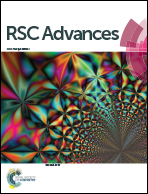Evaluation of poly(pyrrole-2-carboxylic acid) particles synthesized by enzymatic catalysis
Abstract
In this study an environmentally friendly synthesis of poly(pyrrole-2-carboxylic acid) (PCPy) particles dispersed in water–ethanol medium using enzymatic catalysis is proposed. The polymerization of pyrrole-2-carboxylic acid was initiated by the oxidant hydrogen peroxide resulting from the redox enzyme glucose oxidase (GOx) catalyzed glucose oxidation reaction. The main evidence of the polymerization process was the origin and increase of the absorption peak at 465 nm indicating the presence of PCPy oligomers. The PCPy formation rate in different pH medium was investigated and compared with the formation rate of the PCPy synthesized by chemical oxidative polymerization. The best medium for the enzymatic polymerization was determined at pH 5.0, while for the chemical method it was at pH 2.0. The GOx had a significant positive impact on the outcome of the polymerization reaction and colloidal stability of the formed PCPy particles. The GOx catalyzed polymerization reaction was faster than that based on chemical oxidative polymerization but the precipitation of insoluble precipitate was observed after a longer period of polymerization. The morphology of the PCPy particles was characterized by SEM. Additionally, the presence of carboxylic groups in the formed PCPy particles was confirmed by FTIR spectroscopy and potentiometric back-titration.


 Please wait while we load your content...
Please wait while we load your content...